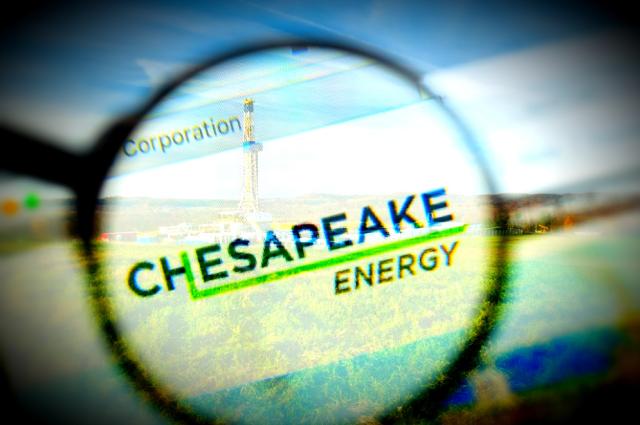
(Source: Hart Energy; Casimiro PT/Shutterstock.com)
Chesapeake Energy Corp. spearheaded the shale revolution a decade ago that ushered in an era of U.S. energy independence, embodying a period of corporate extravagance as it rose to become a $35 billion company.
Now the indebted group is on the brink of a bankruptcy that would make it the biggest casualty of the turmoil sparked by coronavirus that is ravaging America’s oil and gas sector.
Its shares have plunged 90% since January, taking its market capitalization to just $130 million. Bond markets are pricing in default. A reverse stock split in April raised fears of imminent insolvency.

A Chapter 11 filing is at best “a matter of weeks, not months away”, said a restructuring adviser to one of Chesapeake’s creditors, adding that this would open the floodgates for other bankruptcies across the sector.
A smaller Chesapeake, freed of liabilities and more tightly focused on natural gas in the prolific Marcellus Shale of the U.S. Northeast, is likely to emerge from the restructuring.
Doug Lawler, CEO since 2013, has battled for years to clean up the company’s balance sheet and lighten a $23 billion debt pile amassed during a period of explosive growth under predecessor Aubrey McClendon.
“He inherited a company that was unsustainable,” said a former Chesapeake executive. But the coronavirus pandemic and brutal oil-price collapse have hastened the decline. “There’s not much even a great CEO can do to change the reality of the commodity price crash.”
From obscurity, in the late 1980s, Chesapeake became the best-known shale business under the charismatic McClendon, at one point the best-paid U.S. CEO with an annual package topping $100 million.
Its name adorns the arena where the NBA’s Oklahoma City Thunder have played basketball since McClendon helped to buy the team, among his efforts to revitalise the state capital. The company’s sprawling campus was famed for its state-of-the-art gym, teams of chaplains and gardeners, and its bee colony.
They brought the debt down. But the company shrank along with it
—John Thieroff, Moody’s
The beekeepers have gone but Chesapeake’s legacy as shale leader endures—outlasting McClendon, who died in a car crash in 2016 a day after his indictment on charges of rigging bids for drilling rights.
“Without Chesapeake, there is no shale revolution full-stop,” said the restructuring adviser. “But it’s not just a liquidity crisis, it’s a solvency one now. They were just so much further out on a limb than anyone else.”
The company’s insatiable appetite for shale rock made it one of the biggest leaseholders in the U.S. as commodity prices soared in the years before 2008, when ever-bigger bets seemed likely to pay off. Chesapeake believed it only needed to drill the territory—what it called “harvest mode”—to reap the rewards.
It signed up pipeline partners with long-term contracts, paying them handsomely to install the gathering, processing and transportation (GP&T) infrastructure that would open the shale patch and, McClendon insisted, make natural gas the dominant U.S. fuel.
Its stock soared as natural gas prices peaked in 2008, at six times their current level. But the huge land position came with commitments to keep drilling or surrender the acreage. Capex rocketed far above cash earnings. The debt pile bulged.
By the time investors forced McClendon out, Chesapeake was lumbered with mounting off-balance sheet liabilities too, including “volumetric production payments,” a form of selling future production.
Asset sales helped to cut debt below $11 billion by 2018 but also meant lower output, hindering the company’s ability to generate cash and make interest payments, let alone restore a dividend for common stock that was suspended in 2015.
“They brought the debt down,” said John Thieroff, analyst at Moody’s. “But the company shrank along with it.”
Now Chesapeake faces the wall just as a plunge in drilling threatens supply shortfalls that would revive prices.
“It is ironic that just as natural gas prices are about to rip higher this winter—exactly what Chesapeake has been holding out for—they are on the precipice of bankruptcy,” said Andrew Gillick of the consultancy RS Energy Group.
Some analysts believe a forthcoming restructuring will be salutary for a sector that has proved more adept at squeezing hydrocarbons from rocks than repaying investors’ cash.
Lawler pledged in 2013 that his company would generate enough income to cover spending. But free cash flow has only been achieved in two quarters since then, according to S&P Global Market Intelligence.
“It’s hard to generate cash when you’re spending $700 million a year in interest payments and $1.3 billion on GP&T,” said a person familiar with the company’s position.
They sold massive amounts of the gas assets and bought very expensive oil assets. Since then the net debt hasn’t changed a lick
—A former Chesapeake executive
As recently as late February, Lawler said he hoped to recoup up to $500 million from disposals. But the shale era’s natural gas champion is also exposed to the oil-price crash, which has damped asset valuations and buyer appetite.
To hedge against weakness in the natural gas market, Chesapeake—which in 2012 sold its position in Texas’s Permian Basin, now the world’s most productive oilfield—pursued oil deposits in Wyoming and, in 2018, splurged $4 billion to buy the Texas oil producer Wildhorse Resource Development.
However, oil prices traded down consistently in the months after the Wildhorse deal. Cash flow from operations has also trended lower, despite the extra production.
“They sold massive amounts of the gas assets and bought very expensive oil assets,” said the former Chesapeake executive. “Since then the net debt hasn’t changed a lick.”
Downgrading the company’s debt recently, Moody’s noted the toxic combination of “eroding liquidity . . . significant production declines due to substantially reduced capital investment, a depressed commodity price environment, very limited access to capital, and the high likelihood of a restructuring in the near term.”
Bankruptcy would offer freedom from old obligations that have hindered the company.
“They entered into these really expensive term transportation agreements to get gas out of the basins,” said John Kempf, a director at Fitch Ratings. “Bankruptcy in this case can maybe help resolve some of those issues.”
Lawler is likely to remain at the helm, say analysts. A $25 million payout to keep him and other executives was recently agreed despite the company’s weakened cash position. He emailed staff last month saying Chesapeake would “operate our business as usual” through a restructuring, while benefits and bonuses had been enhanced to reward employees.
Investors hope the company that emerges will look more like Cabot Oil & Gas Corp., a rival in the Appalachian Basin’s Marcellus Shale, where Chesapeake holds a prized position.
Cabot produced about 394,000 boe/d in the first quarter of this year, compared with Chesapeake’s 479,000. But it generated free cash flow of almost $50 million, against Chesapeake’s negative $115 million, and its stock has outperformed the S&P 500 this year as Chesapeake’s has been demolished.
The bankruptcy process should be relatively smooth, advisers say. Chesapeake has appointed the law firm Kirkland and Ellis, and investment banks Rothschild and Intrepid Financial Partners to help with its restructuring. Creditors including Franklin Resources have recruited their teams.
Chesapeake and the other parties declined to comment.
“Everyone’s had a head start and everyone’s armed with their spreadsheets,” said the adviser involved in the negotiations. The bankruptcy will “set a precedent for the 50 [other shale companies] that are going to come in the next two years.”
Who will own the reset Chesapeake? Private equity investors, though bruised by the shale patch in recent years, remain the likeliest buyers. A sale of the company’s constituent parts is also possible.
The smaller Marcellus specialist likely to emerge will be a far cry from the expansive, world-beating energy disrupter McClendon and Wall Street created. It is hard to avoid the conclusion that an era will be drawing to a close.
Recommended Reading
CEO: Continental Adds Midland Basin Acreage, Explores Woodford, Barnett
2024-04-11 - Continental Resources is adding leases in Midland and Ector counties, Texas, as the private E&P hunts for drilling locations to explore. Continental is also testing deeper Barnett and Woodford intervals across its Permian footprint, CEO Doug Lawler said in an exclusive interview.
Chevron Hunts Upside for Oil Recovery, D&C Savings with Permian Pilots
2024-02-06 - New techniques and technologies being piloted by Chevron in the Permian Basin are improving drilling and completed cycle times. Executives at the California-based major hope to eventually improve overall resource recovery from its shale portfolio.
For Sale, Again: Oily Northern Midland’s HighPeak Energy
2024-03-08 - The E&P is looking to hitch a ride on heated, renewed Permian Basin M&A.
Galp Seeks to Sell Stake in Namibia Oilfield After Discovery, Sources Say
2024-04-22 - Portuguese oil company Galp Energia has launched the sale of half of its stake in an exploration block offshore Namibia.
Sinopec Brings West Sichuan Gas Field Onstream
2024-03-14 - The 100 Bcm sour gas onshore field, West Sichuan Gas Field, is expected to produce 2 Bcm per year.




